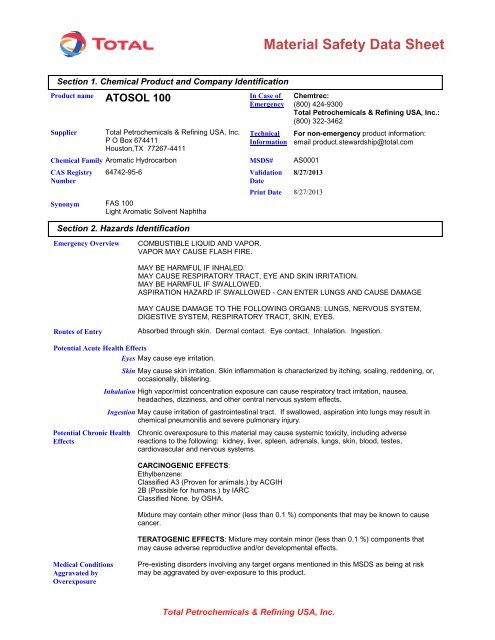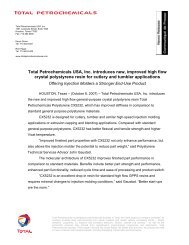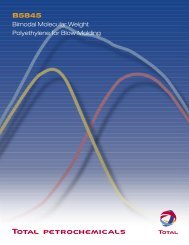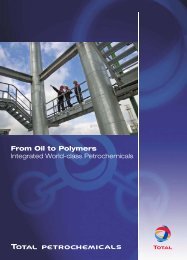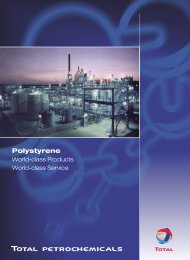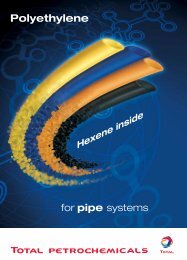Atosol 100 MSDS - Total Petrochemicals USA
Atosol 100 MSDS - Total Petrochemicals USA
Atosol 100 MSDS - Total Petrochemicals USA
You also want an ePaper? Increase the reach of your titles
YUMPU automatically turns print PDFs into web optimized ePapers that Google loves.
Material Safety Data Sheet<br />
Section 1. Chemical Product and Company Identification<br />
Product name<br />
Supplier<br />
Chemical Family Aromatic Hydrocarbon<br />
CAS Registry 64742-95-6<br />
Number<br />
Synonym<br />
ATOSOL <strong>100</strong><br />
<strong>Total</strong> <strong>Petrochemicals</strong> & Refining <strong>USA</strong>, Inc.<br />
P O Box 674411<br />
Houston,TX 77267-4411<br />
FAS <strong>100</strong><br />
Light Aromatic Solvent Naphtha<br />
Section 2. Hazards Identification<br />
In Case of<br />
Emergency<br />
Technical<br />
Information<br />
<strong>MSDS</strong>#<br />
Validation<br />
Date<br />
Print Date<br />
Chemtrec:<br />
(800) 424-9300<br />
<strong>Total</strong> <strong>Petrochemicals</strong> & Refining <strong>USA</strong>, Inc.:<br />
(800) 322-3462<br />
For non-emergency product information:<br />
email product.stewardship@total.com<br />
AS0001<br />
8/27/2013<br />
8/27/2013<br />
Emergency Overview<br />
COMBUSTIBLE LIQUID AND VAPOR.<br />
VAPOR MAY CAUSE FLASH FIRE.<br />
MAY BE HARMFUL IF INHALED.<br />
MAY CAUSE RESPIRATORY TRACT, EYE AND SKIN IRRITATION.<br />
MAY BE HARMFUL IF SWALLOWED.<br />
ASPIRATION HAZARD IF SWALLOWED - CAN ENTER LUNGS AND CAUSE DAMAGE<br />
MAY CAUSE DAMAGE TO THE FOLLOWING ORGANS: LUNGS, NERVOUS SYSTEM,<br />
DIGESTIVE SYSTEM, RESPIRATORY TRACT, SKIN, EYES.<br />
Routes of Entry<br />
Absorbed through skin. Dermal contact. Eye contact. Inhalation. Ingestion.<br />
Potential Acute Health Effects<br />
Eyes May cause eye irritation.<br />
Skin May cause skin irritation. Skin inflammation is characterized by itching, scaling, reddening, or,<br />
occasionally, blistering.<br />
Inhalation High vapor/mist concentration exposure can cause respiratory tract irritation, nausea,<br />
headaches, dizziness, and other central nervous system effects.<br />
Ingestion May cause irritation of gastrointestinal tract. If swallowed, aspiration into lungs may result in<br />
chemical pneumonitis and severe pulmonary injury.<br />
Potential Chronic Health<br />
Effects<br />
Chronic overexposure to this material may cause systemic toxicity, including adverse<br />
reactions to the following: kidney, liver, spleen, adrenals, lungs, skin, blood, testes,<br />
cardiovascular and nervous systems.<br />
CARCINOGENIC EFFECTS:<br />
Ethylbenzene:<br />
Classified A3 (Proven for animals.) by ACGIH<br />
2B (Possible for humans.) by IARC<br />
Classified None. by OSHA.<br />
Mixture may contain other minor (less than 0.1 %) components that may be known to cause<br />
cancer.<br />
TERATOGENIC EFFECTS: Mixture may contain minor (less than 0.1 %) components that<br />
may cause adverse reproductive and/or developmental effects.<br />
Medical Conditions<br />
Aggravated by<br />
Overexposure<br />
Pre-existing disorders involving any target organs mentioned in this <strong>MSDS</strong> as being at risk<br />
may be aggravated by over-exposure to this product.<br />
<strong>Total</strong> <strong>Petrochemicals</strong> & Refining <strong>USA</strong>, Inc.
ATOSOL <strong>100</strong> Page: 2/9<br />
Overexposure /Signs/<br />
Symptoms<br />
See Toxicological Information (Section 11)<br />
_<br />
Prolonged or repeated exposure to this product can cause central nervous system effects<br />
(headache, excitation, euphoria, dizziness, incoordination, drowsiness, light-headedness,<br />
blurred vision, fatigue, tremors, convulsions, loss of consciousness, respiratory arrest and<br />
death) and irritation to the eyes, skin, and respiratory tract. Frequent skin contact can<br />
remove skin oils, resulting in dermatitis.<br />
Section 3. Composition and Information on Ingredients<br />
Occupational exposure limits, if available, are listed in Section 8.<br />
Substance Name<br />
CAS #<br />
% by Weight<br />
Solvent naphtha (petroleum), light arom. 64742-95-6 <strong>100</strong><br />
1,2,4-trimethylbenzene 95-63-6 10 - 35<br />
3-ethyltoluene 620-14-4 10 - 20<br />
mesitylene 108-67-8 5 - 10<br />
2-ethyltoluene 611-14-3 3 - 9<br />
4-ethyltoluene 622-96-8 3 - 9<br />
1,2,3-trimethylbenzene 526-73-8 3 - 7<br />
propylbenzene 103-65-1 3 - 7<br />
o-xylene 95-47-6 2 - 6<br />
cumene 98-82-8 1 - 2<br />
m-xylene 108-38-3 0.2 - 1<br />
p-xylene 106-42-3 0.1 - 0.5<br />
ethylbenzene <strong>100</strong>-41-4 0 - 0.5<br />
toluene 108-88-3
ATOSOL <strong>100</strong> Page: 3/9<br />
Section 6. Accidental Release Measures<br />
_<br />
Small Spill and Leak<br />
Large Spill and Leak<br />
Absorb with an inert material and put the spilled material in an appropriate waste disposal.<br />
Contain spill and safely stop the flow.<br />
Warn personnel to move away.<br />
Eliminate all sources of ignition.<br />
Ventilate.<br />
Absorb with an inert material (sand) and put the spilled material in an appropriate waste<br />
disposal.<br />
Dike spill area and do not allow product to reach sewage system and surface or ground water.<br />
Keep out of waterways.<br />
Section 7. Handling and Storage<br />
Handling<br />
Storage<br />
Put on appropriate personal protective equipment (see Section 8). Eating, drinking and<br />
smoking should be prohibited in areas where this material is handled, stored and processed.<br />
Workers should wash hands and face before eating, drinking and smoking. Do not breathe<br />
vapor or mist. Do not ingest. Avoid contact with eyes, skin and clothing. Use only with<br />
adequate ventilation. Wear appropriate respirator when ventilation is inadequate. Do not<br />
enter storage areas and confined spaces unless adequately ventilated. Keep in the original<br />
container or an approved alternative made from a compatible material, kept tightly closed<br />
when not in use. Store and use away from heat, sparks, open flame or any other ignition<br />
source. Use explosion-proof electrical (ventilating, lighting and material handling) equipment.<br />
Use non-sparking tools. Take precautionary measures against electrostatic discharges. To<br />
avoid fire or explosion, dissipate static electricity during transfer by grounding and bonding<br />
containers and equipment before transferring material. Empty containers retain product<br />
residue and can be hazardous. Do not reuse container.<br />
Keep away from heat.<br />
Keep away from sources of ignition.<br />
Keep container tightly closed.<br />
Keep in a cool and well-ventilated area.<br />
Ground all equipment containing material.<br />
Keep container dry.<br />
Keep in a cool place.<br />
Combustible materials should be stored away from extreme heat and away from strong<br />
oxidizing agents.<br />
All efforts should be made to prevent any leaks or spills. Storage tanks containing should be<br />
engineered to prevent contact with water resources, as this material could contaminate the<br />
water resources. Surface spills can reach groundwater through porous soil or cracked<br />
surfaces. The storage tanks should be monitored regularly for leaks. Where spills or leaks are<br />
possible, a comprehensive response plan should be developed and implemented.<br />
Section 8. Exposure Controls/Personal Protection<br />
Engineering Controls Provide exhaust ventilation or other engineering controls to keep the airborne concentrations<br />
of vapors below their respective threshold limit value. Ensure that eyewash stations and<br />
safety showers are proximal to the work-station location.<br />
Personal Protection<br />
Eyes Safety glasses with side shields.<br />
Body Flame retardant clothing covering the entire body.<br />
Respiratory Use a MSHA/NIOSH approved respirator or equivalent at high concentrations.<br />
Hands Chemical resistant gloves if contact is possible.<br />
Protective Clothing<br />
(Pictograms)<br />
Feet Shoes.<br />
Personal Protection in<br />
Case of a Large Spill<br />
Product Name<br />
Splash goggles. Full suit. Vapor respirator. Boots. Gloves. A self contained breathing<br />
apparatus should be used to avoid inhalation of the product. Suggested protective clothing<br />
might not be sufficient; consult a specialist BEFORE handling this product.<br />
Exposure Limits<br />
<strong>Total</strong> <strong>Petrochemicals</strong> & Refining <strong>USA</strong>, Inc.
ATOSOL <strong>100</strong> Page: 4/9<br />
Solvent naphtha (petroleum), light arom. -<br />
1,2,4-trimethylbenzene ACGIH TLV (United States, 3/2012).<br />
TWA: 25 ppm 8 hours.<br />
TWA: 123 mg/m³ 8 hours.<br />
NIOSH REL (United States, 6/2009).<br />
TWA: 25 ppm 10 hours.<br />
TWA: 125 mg/m³ 10 hours.<br />
3-ethyltoluene -<br />
mesitylene ACGIH TLV (United States, 3/2012).<br />
TWA: 25 ppm 8 hours.<br />
TWA: 123 mg/m³ 8 hours.<br />
NIOSH REL (United States, 6/2009).<br />
TWA: 25 ppm 10 hours.<br />
TWA: 125 mg/m³ 10 hours.<br />
2-ethyltoluene -<br />
4-ethyltoluene -<br />
1,2,3-trimethylbenzene ACGIH TLV (United States, 3/2012).<br />
TWA: 25 ppm 8 hours.<br />
TWA: 123 mg/m³ 8 hours.<br />
NIOSH REL (United States, 6/2009).<br />
TWA: 25 ppm 10 hours.<br />
TWA: 125 mg/m³ 10 hours.<br />
propylbenzene -<br />
o-xylene NIOSH REL (United States, 6/2009).<br />
TWA: <strong>100</strong> ppm 10 hours.<br />
STEL: 150 ppm 15 minutes.<br />
TWA: 435 mg/m³ 10 hours.<br />
STEL: 655 mg/m³ 15 minutes.<br />
ACGIH TLV (United States, 3/2012).<br />
TWA: <strong>100</strong> ppm 8 hours.<br />
TWA: 434 mg/m³ 8 hours.<br />
STEL: 150 ppm 15 minutes.<br />
STEL: 651 mg/m³ 15 minutes.<br />
OSHA PEL (United States, 6/2010).<br />
TWA: <strong>100</strong> ppm 8 hours.<br />
TWA: 435 mg/m³ 8 hours.<br />
cumene<br />
NIOSH REL (United States, 6/2009). Absorbed through skin.<br />
TWA: 50 ppm 10 hours.<br />
TWA: 245 mg/m³ 10 hours.<br />
ACGIH TLV (United States, 3/2012).<br />
TWA: 50 ppm 8 hours.<br />
OSHA PEL (United States, 6/2010). Absorbed through skin.<br />
TWA: 50 ppm 8 hours.<br />
TWA: 245 mg/m³ 8 hours.<br />
m-xylene NIOSH REL (United States, 6/2009).<br />
TWA: <strong>100</strong> ppm 10 hours.<br />
STEL: 150 ppm 15 minutes.<br />
TWA: 435 mg/m³ 10 hours.<br />
STEL: 655 mg/m³ 15 minutes.<br />
ACGIH TLV (United States, 3/2012).<br />
TWA: <strong>100</strong> ppm 8 hours.<br />
TWA: 434 mg/m³ 8 hours.<br />
STEL: 150 ppm 15 minutes.<br />
STEL: 651 mg/m³ 15 minutes.<br />
OSHA PEL (United States, 6/2010).<br />
TWA: <strong>100</strong> ppm 8 hours.<br />
TWA: 435 mg/m³ 8 hours.<br />
p-xylene NIOSH REL (United States, 6/2009).<br />
TWA: <strong>100</strong> ppm 10 hours.<br />
STEL: 150 ppm 15 minutes.<br />
TWA: 435 mg/m³ 10 hours.<br />
STEL: 655 mg/m³ 15 minutes.<br />
ACGIH TLV (United States, 3/2012).<br />
TWA: <strong>100</strong> ppm 8 hours.<br />
TWA: 434 mg/m³ 8 hours.<br />
STEL: 150 ppm 15 minutes.<br />
STEL: 651 mg/m³ 15 minutes.<br />
OSHA PEL (United States, 6/2010).<br />
TWA: <strong>100</strong> ppm 8 hours.<br />
TWA: 435 mg/m³ 8 hours.<br />
ethylbenzene OSHA PEL (United States, 6/2010).<br />
TWA: <strong>100</strong> ppm 8 hours.<br />
TWA: 435 mg/m³ 8 hours.<br />
NIOSH REL (United States, 6/2009).<br />
<strong>Total</strong> <strong>Petrochemicals</strong> & Refining <strong>USA</strong>, Inc.<br />
_
ATOSOL <strong>100</strong> Page: 5/9<br />
_<br />
TWA: <strong>100</strong> ppm 10 hours.<br />
STEL: 125 ppm 15 minutes.<br />
TWA: 435 mg/m³ 10 hours.<br />
STEL: 545 mg/m³ 15 minutes.<br />
ACGIH TLV (United States, 3/2012).<br />
TWA: 20 ppm 8 hours.<br />
toluene ACGIH TLV (United States, 3/2012).<br />
TWA: 20 ppm 8 hours.<br />
OSHA PEL Z2 (United States, 11/2006).<br />
TWA: 200 ppm 8 hours.<br />
CEIL: 300 ppm<br />
AMP: 500 ppm 10 minutes.<br />
NIOSH REL (United States, 6/2009).<br />
TWA: <strong>100</strong> ppm 10 hours.<br />
STEL: 150 ppm 15 minutes.<br />
TWA: 375 mg/m³ 10 hours.<br />
STEL: 560 mg/m³ 15 minutes.<br />
benzene NIOSH REL (United States, 6/2009).<br />
TWA: 0.1 ppm 10 hours.<br />
STEL: 1 ppm 15 minutes.<br />
OSHA PEL (United States, 6/2010).<br />
TWA: 1 ppm 8 hours.<br />
STEL: 5 ppm 15 minutes.<br />
ACGIH TLV (United States, 3/2012). Absorbed through skin.<br />
TWA: 0.5 ppm 8 hours.<br />
TWA: 1.6 mg/m³ 8 hours.<br />
STEL: 2.5 ppm 15 minutes.<br />
STEL: 8 mg/m³ 15 minutes.<br />
Consult local authorities for acceptable exposure limits.<br />
Section 9. Physical and Chemical Properties<br />
Physical State and Appearance<br />
Color<br />
Odor<br />
Molecular Weight<br />
Molecular Formula<br />
Boiling/Condensation Point<br />
Specific Gravity<br />
Vapor Pressure<br />
Liquid.<br />
Clear.<br />
Aromatic.<br />
Not determined.<br />
Not applicable.<br />
148 to 177°C (299 to 351°F)<br />
0.86 to 0.88 (Water = 1)<br />
< 10 mm Hg at 20°C<br />
Vapor Density<br />
Volatility<br />
VOC<br />
Solubility in Water<br />
3.5 (Air = 1)<br />
<strong>100</strong>% (v/v).<br />
<strong>100</strong> (%)<br />
Negligible.<br />
Section 10. Stability and Reactivity<br />
Stability and Reactivity<br />
Conditions of Instability<br />
Incompatibility with<br />
Various Substances<br />
Hazardous<br />
Decomposition Products<br />
Hazardous<br />
Polymerization<br />
The product is stable.<br />
No additional remark.<br />
Extremely reactive or incompatible with oxidizing agents.<br />
carbon monoxide & carbon dioxide<br />
Under normal conditions of storage and use, hazardous polymerization will not occur.<br />
<strong>Total</strong> <strong>Petrochemicals</strong> & Refining <strong>USA</strong>, Inc.
ATOSOL <strong>100</strong> Page: 6/9<br />
Section 11. Toxicological Information<br />
Toxicity to Animals<br />
Chronic Effects on<br />
Humans<br />
Other Toxic Effects on<br />
Humans<br />
_<br />
Product/ingredient name Result Species Dose Exposure<br />
1,2,4-trimethylbenzene LD50 Oral Rat 5 g/kg -<br />
LC50 Inhalation Vapor Rat 18000 mg/m3 4 hours<br />
1,3,5-Trimethylbenzene LD50 Oral Rat 5000 mg/kg -<br />
TDLo Subcutaneous Rat 12 mL/kg -<br />
LC50 Inhalation Vapor Rat 24000 mg/m3 4 hours<br />
4-ethyltoluene LD50 Intraperitoneal Rat 1122 mg/kg -<br />
LD50 Oral Rat 4850 mg/kg -<br />
1,2,3-trimethylbenzene LDLo Oral Rat 10 mL/kg -<br />
o-xylene LD50 Oral Rat 3567 mg/kg -<br />
cumene LD50 Dermal Rabbit 12300 uL/kg -<br />
LD50 Oral Rat 2.9 gm/kg -<br />
LD50 Oral Rat 1400 mg/kg -<br />
LC50 Inhalation Vapor Rat 39000 mg/m3 4 hours<br />
ethylbenzene LD50 Dermal Rabbit >5000 mg/kg -<br />
LD50 Dermal Rabbit 17800 uL/kg -<br />
LD50 Oral Rat 3500 mg/kg -<br />
LC50 Inhalation Vapor Rat 55000 mg/m3 2 hours<br />
solvent naphtha<br />
(petroleum), light arom.<br />
LD50 Oral Rat 8400 mg/kg -<br />
The substance is toxic to lungs, the nervous system, digestive system, upper respiratory tract,<br />
skin, eyes.<br />
May be irritating to eyes, skin and respiratory system. Aspiration hazard if swallowed. Can<br />
enter lungs and cause damage.<br />
Special Remarks on<br />
Chronic Effects on<br />
Humans<br />
Chronic overexposure to this material may cuase systemic toxicity, including adverse<br />
reactions to the following: kidney, liver, spleen, adrenals, lungs, skin, blood, testes,<br />
cardiovascular and nervous systems.<br />
Section 12. Ecological Information<br />
Ecotoxicity<br />
Mobility<br />
Special Remarks on the<br />
Products of<br />
Biodegradation<br />
Not available.<br />
Section 13. Disposal Considerations<br />
Waste Information<br />
Consult your local or regional authorities.<br />
Constituents of this type of aromatic solvent are expected to partition between air, water, and<br />
soil.<br />
Constituents of this type of aromatic solvent are expected to biodegrade.<br />
Recover free liquid. Transfer to a safe disposal area in accordance with federal, state, and<br />
local regulations.<br />
This material, as supplied, when discarded or disposed of, is a hazardous waste according<br />
to Federal regulations (40 CFR 261) due to its ignitability and due the composition containing<br />
some listed components (toluene, xylenes, cumene and others). Under RCRA, it is the<br />
responsibility of the user of the product to determine, at the time of disposal, whether the<br />
material is a hazardous waste.<br />
The transportation, storage, treatment and disposal of RCRA waster material must be<br />
conducted in compliance with 40 CFR 262, 263, 264. 268, and 270. Disposal can occur only<br />
in properly permitted facilities. Chemical additions, processing or otherwise altering this<br />
material may make the waste management information presented in the <strong>MSDS</strong> incomplete,<br />
inaccurate, or other inappropriate.<br />
<strong>Total</strong> <strong>Petrochemicals</strong> & Refining <strong>USA</strong>, Inc.
ATOSOL <strong>100</strong> Page: 7/9<br />
_<br />
Section 14. Transport Information<br />
(for domestic bulk shipments, non-bulk shipments may differ)<br />
DOT Classification for<br />
Bulk Shipments (non bulk<br />
shipments may differ)<br />
Proper Shipping Name/<br />
Description<br />
UN Number<br />
Packing Group<br />
Marine Pollutant<br />
DOT Class: 3 - Combustible liquid with a flash point<br />
greater than 37.8°C (<strong>100</strong>°F).<br />
UN1268, Petroleum Distillates, n.o.s., 3, PGIII RQ (mixed xylenes, ethylbenzene)<br />
UN1268<br />
III<br />
Not listed in Appendix B to 49CFR172.101<br />
Hazardous Substances<br />
Reportable Quantity<br />
Special Provisions for<br />
Transport<br />
TDG Classification<br />
IMO/IMDG Classification<br />
ICAO/IATA Classification<br />
USCG Proper<br />
Shipping Name<br />
Cumene 5,000 lbs<br />
Xylene (mixed isomers) <strong>100</strong> lbs<br />
Ethylbenzene <strong>100</strong>0 lbs<br />
See codes as shown in 49 CFR 172.101 column 7.<br />
TDG Class 3: Flammable liquid.<br />
IMDG Class 3: Flammable liquid.<br />
IATA Class 3: Flammable liquid.<br />
Naphtha: Aromatic<br />
Section 15. Regulatory Information<br />
HCS Classification<br />
U.S. Federal Regulations<br />
Combustible liquid<br />
Carcinogen<br />
Target organ effects<br />
TSCA 8(a) CDR Exempt/Partial exemption: Partial exemption<br />
United States inventory (TSCA 8b): Product is listed on TSCA inventory under CAS RN<br />
64742-95-6.<br />
International Regulations<br />
SARA 302/304/311/312 extremely hazardous substances: To the best of our knowledge,<br />
there are no substances that would be at reportable levels for this regulation in this product.<br />
SARA 302/304 emergency planning and notification: To the best of our knowledge, there<br />
are no substances that would be at reportable levels for this regulation in this product.<br />
SARA 302/304/311/312 hazardous chemicals: solvent naphtha (petroleum), light arom.<br />
SARA 311/312 <strong>MSDS</strong> distribution - chemical inventory - hazard identification: solvent<br />
naphtha (petroleum), light arom.: Fire hazard, Immediate (acute) health hazard, Delayed<br />
(chronic) health hazard<br />
SARA 313 Supplier Notification<br />
This product contains the following EPCRA section 313 chemicals subject to the reporting<br />
requirements of section 313 of the Emergency Planning and Community Right-to-Know Act<br />
of 1986 (40 CFR 372 -Table 372.65).<br />
Product name CAS number Concentration (%)<br />
1,2,4-trimethylbenzene 95-63-6 10 - 35<br />
o-xylene 95-47-6 2 - 6<br />
cumene 98-82-8 1 - 2<br />
ethylbenzene <strong>100</strong>-41-4 0 - 0.5<br />
m-xylene 108-38-3 0.2 - 1<br />
Clean Water Act (CWA) 307: ethylbenzene; toluene<br />
Clean Water Act (CWA) 311: o-xylene; m-xylene; p-xylene; ethylbenzene; toluene<br />
WHMIS (Canada) Class B-3: Combustible liquid with a flash point between 37.8°C (<strong>100</strong>°F) and 93.3°C (200°F).<br />
Class D-2B: Material causing other toxic effects (Toxic).<br />
<strong>Total</strong> <strong>Petrochemicals</strong> & Refining <strong>USA</strong>, Inc.
ATOSOL <strong>100</strong> Page: 8/9<br />
DSCL (EEC)<br />
CEPA DSL/NDSL<br />
International Lists<br />
State Regulations<br />
_<br />
CEPA Toxic substances: None of the components are listed.<br />
Canadian ARET: None of the components are listed.<br />
Canadian NPRI: The following components are listed: Light aromatic solvent naphtha<br />
Alberta Designated Substances: None of the components are listed.<br />
Ontario Designated Substances: None of the components are listed.<br />
Quebec Designated Substances: None of the components are listed.<br />
R65- Harmful: may cause lung damage if swallowed.<br />
All components are listed or exempted.<br />
Australia inventory (AICS): All components are listed or exempted.<br />
China inventory (IECSC): All components are listed or exempted.<br />
Japan inventory: Not determined.<br />
Korea inventory: All components are listed or exempted.<br />
Malaysia Inventory (EHS Register): All components are listed or exempted.<br />
New Zealand Inventory of Chemicals (NZIoC): All components are listed or exempted.<br />
Philippines inventory (PICCS): All components are listed or exempted.<br />
Taiwan inventory (CSNN): Not determined.<br />
Massachusetts Substances: The following components are listed: PSEUDOCUMENE;<br />
MESITYLENE; TRIMETHYL BENZENE; PROPYLBENZENE; O-XYLENE; CUMENE<br />
New Jersey Hazardous Substances: The following components are listed:<br />
PSEUDOCUMENE; ETHYLTOLUENES; BENZENE, ETHYLMETHYL-; TRIMETHYL<br />
BENZENE (mixed isomers); BENZENE, TRIMETHYL-; ETHYLTOLUENES; BENZENE,<br />
ETHYLMETHYL-; ETHYLTOLUENES; BENZENE, ETHYLMETHYL-; TRIMETHYL BENZENE;<br />
PROPYL BENZENE; o-XYLENE; BENZENE, 1,2-DIMETHYL-; CUMENE; ETHYL BENZENE<br />
New York Acutely Hazardous Substances: The following components are listed: o-Xylene;<br />
Benzene,1-methylethyl-; Ethylbenzene<br />
Pennsylvania RTK Hazardous Substances: The following components are listed:<br />
PSEUDOCUMENE; BENZENE, TRIMETHYL-; BENZENE, TRIMETHYL-; BENZENE,<br />
PROPYL-; BENZENE, 1,2-DIMETHYL-; BENZENE, (1-METHYLETHYL)-; BENZENE, ETHYL-<br />
California Propostion 65: This product contains the following ingredients for which the State of<br />
California has found to cause cancer, birth defects or other reproductive harm, which would<br />
require a warning under the statute: Ethylbenzene, Toluene, Benzene, Cumene<br />
Section 16. Other Information<br />
Label requirements COMBUSTIBLE LIQUID AND VAPOR.<br />
VAPOR MAY CAUSE FLASH FIRE.<br />
MAY BE HARMFUL IF INHALED.<br />
MAY CAUSE RESPIRATORY TRACT, EYE AND SKIN IRRITATION.<br />
MAY BE HARMFUL IF SWALLOWED.<br />
ASPIRATION HAZARD IF SWALLOWED - CAN ENTER LUNGS AND CAUSE DAMAGE<br />
Hazardous Material<br />
Information System<br />
(U.S.A.)<br />
MAY CAUSE DAMAGE TO THE FOLLOWING ORGANS: LUNGS, NERVOUS SYSTEM,<br />
DIGESTIVE SYSTEM, RESPIRATORY TRACT, SKIN, EYES.<br />
Health<br />
Fire Hazard<br />
Reactivity<br />
Personal Protection<br />
*<br />
2<br />
2<br />
0<br />
G<br />
National Fire<br />
Protection<br />
Association<br />
(U.S.A.)<br />
Health<br />
2<br />
2<br />
0<br />
Fire Hazard<br />
Reactivity<br />
Specific Hazard<br />
References<br />
-HSDB - Hazardous Substances Data Bank<br />
Chemtox Database<br />
Validated on 8/27/2013.<br />
Printed 8/27/2013.<br />
<strong>Total</strong> <strong>Petrochemicals</strong> & Refining <strong>USA</strong>, Inc.
ATOSOL <strong>100</strong> Page: 9/9<br />
Chemtrec:<br />
(800) 424-9300<br />
<strong>Total</strong> <strong>Petrochemicals</strong> & Refining <strong>USA</strong>, Inc.:<br />
(800) 322-3462<br />
Notice to Reader<br />
To the best of our knowledge, the information contained herein is accurate. However, neither the above named supplier nor any of its subsidiaries assumes any<br />
liability whatsoever for the accuracy or completeness of the information contained herein. Final determination of suitability of any material is the sole<br />
responsibility of the user. All materials may present unknown hazards and should be used with caution. Although certain hazards are described herein, we<br />
cannot guarantee that these are the only hazards that exist.<br />
<strong>MSDS</strong> Name ATOSOL <strong>100</strong> <strong>MSDS</strong> Code ATOSOL_<strong>100</strong><br />
35.04<br />
_<br />
To obtain an electronic copy of this <strong>MSDS</strong>, please email: product.stewardship@total.com.<br />
<strong>Total</strong> <strong>Petrochemicals</strong> & Refining <strong>USA</strong>, Inc.


